Catalogo:
Via Trionfale «S. Girolamo sul lib. degli scrittori Ecclesiastici.»
The Triumphal Route – S. Girolamo in the book of ecclesiastical writers
The via Triumphalis began at the pons Neronianus, and ran northwest, crossing the via Cornelia. After the destruction of the pons Neronianus, this road really began at the via Cornelia. Its pavement has been found between the Borgo and the piazza del Risorgimento, but does not correspond with any modern street. (Platner)
book on the Campo Marzio
1995.01.03
After the chapter of the long axis, there will be a chapter on the triumphal processional route. This will engage the long axis and then cross the Tiber River and go through the Piazza Navona part of contemporary Rome, and end up at a gate in the Roman wall. Along this path, many buildings and monuments will be passed and will provide material for discussion. In particular there will be a group of buildings that have archeological verification.
I just realized that the second chapter of the book will not be the processional route, but rather the Hadrian axis that crosses the long axis, and is the second longest axis in the entire plan.
Then after the processional route, I'd like to address the Via Flaminia, the only street (as far as I can tell) that is named in the plan.
Area Martis
1995.01.03
The Templum Martis is also the destination point [sic] of the triumphal processional route.
Area Martis
1995.01.03
The fact that the triumphal processional route ends [sic] at the Templum Martis is Piranesi himself telling us that this complex is the most significant / symbolic / sacred place within the entire plan.
This sacred precinct generates a lot of energy and force, and the long thoroughfare axis is the greatest manifestation of the force the precinct projected. The design of the Mars complex also projects strong sexual connotations. The plan of the Templum Martis is self-evidently evocative of a penis and testicles--a fitting metaphor for the male god of war. Conversely, the layout of the Area Martis has as open center flanked by a pair of identical monuments--perhaps a reference to the female sex and reproductive organs, the vagina and the overies. Together, the Templem Martis and the Area Martis represent, or, put another way, the plan formations visually anthropomorphize in plan form, the essence of sexual intercourse and the mechanics of human conception. The conception of the Campo Marzio, archeologically, historically and relative to Piranesi's publication, and specifically in the Ichnographia, is the sacred precinct of Mars.
Triumphal Way - new ideas
1997.01.15
...it starts [sic] at the Templum Jani, and this is significant because of Janus' connection with Rome and war. Furthermore, the notion of Janus as beginning/ending is also significant, and the "way" beginning (and conversely ending) at Janus is complimented be the way ending (and conversely beginning) at the Area Martis.
As the route proceeds from the Janus sector, it makes its way through the Campo Marzio's "theater district"--in every way a "downtown," commercial/entertainment zone complete with shops, small baths, and brothels. ...this type of urban area makes Piranesi's plan/program of the Campo Marzio not unlike any major metropolis today.
As the "way" proceeds further, it crosses the Tiber and an area that is almost the antithesis of the "theater district," i.e., the Bustum Hadriani--one huge cemetery. Going from one extreme to another gives the "way" a potent symbolic nature...
Exhibit 1 text
1997.03.20
Life and Death within Piranesi's Ichnographia of the Campo Marzio
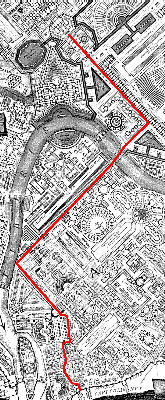
With a consistent dashed line, Piranesi demarcates the Triumphal Way through the Campo Marzio. The processional route begins, with historical and archeological accuracy, at the Templum Jani, which is situated at the bottom of the Ichnographia. The victor's march weaves through Rome's "theater district"--past small baths, shops, and brothels--and then continues on a long straight course towards the Tiber. Across the river, the procession turns behind the Sepulchrum Hadriani and approaches its end at the Templum Martis, the god of War and for whom the Campo Marzio is named. As the ultimate destination of the Triumphal Way, the Templum Martis is clearly among the most sacred, if not the most sacred, of places within the Campo Marzio, and, therefore, perhaps offers a key that lifts the Campo Marzio's "mask."
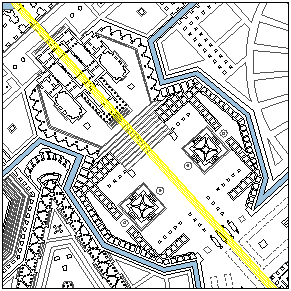
The Templum Martis fittingly promulgates overt manliness. Male genitalia boldly inform the Temple's plan, and the linear projection of the Temple's "endowment" manifests the Campo Marzio's longest straight axis.
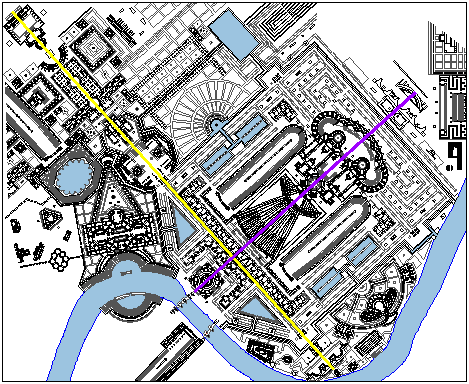
As the axis of Mars spans from the Vatican Hill to the bend in the Tiber, it intersects the Campo Marzio's second longest straight axis, which bisects Hadrian's Tomb and the Bustum Hadriani. The perpendicular crossing of the two axes naturally creates a diametrical opposition. Geometry alone, however, does not represent the depth of their oppositeness.
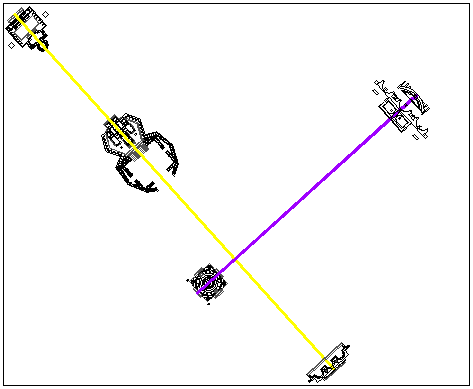
The axis of Mars terminates at either end with a nymphaeum, while the axis through the Bustum Hadriani terminates at either end with an Imperial Tomb. The antithesis of nymphaeums and tombs is self-evident, and, therefore, attests to the axis of Mars representing life and the Bustum axis representing death.
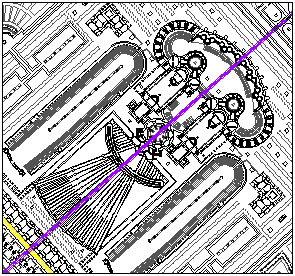
The Bustum Hadriani with its crematoriums and funereal banqueting halls, moreover, is nothing less that a gigantic "machine" to facilitate the passage from this life to the next. Yet, for all its architectural bombast, the Bustum Hadriani can in no way compete with the exalted simplicity of the tiny unnamed structure, which is behind the nymphaeum on the bank of the Tiber and at the very tip of the axis of life.
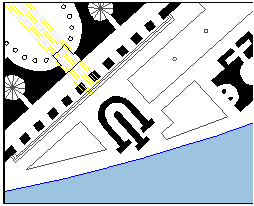
| |
Campo Marzio index
1997.08.05
Beginning the analysis of the Campo Marzio with Mars leads directly to the triumphal way and the long axis, hence the promenade architecturale and the axes of life and death. Then discuss the equirria and the military axis.
architectural promenade
1997.08.05
...the new ideas re: the architectural promenade that developed because of the Danteum. Essentially, the Danteum has the same sequential series of architectural "events" as the formula for the architectural promenade that I have extracted from Le Corbusier and Stirling. The Danteum, however, adds the element of a journey from the profane to the sacred, and this addition significantly opens up the interpretive field and the buildings that can now be included as exhibiting the architectural promenade formula.
With regard to the profane/scared aspect, the triumphal way within Piranesi's Campo Marzio exhibits the same sequence. The procession (promenade) begins at the Templum Jani, a tetrahedron, which is the forest, the pilotis that raise the box. From there the route jaggedly marches through the "theater district" (downtown)--this is hell, the profane, the lower level. Just as the "way" approaches the Banks of the Tiber for the first time, the procession becomes straight and passes repetitive / monotonous buildings. The way remains perfectly straight except for two 90 degree turns, and this course comprises the greatest length of the promenade. (The straight portion of the procession passes, in sequential order, the Hecatonstylon and the outer niched wall of the Horti prius Pompejani deim Marci Antonii; then the long portico of the Stadium opposite the Domus Alexandri Severi; and across the river between the Porticus Hadriani and the Sepulchrum Libertorum et Servorum of the Bustum Hadriani. These buildings well exemplify the notion of inside/outside, thus tying the triumphal way more closely to the architectural promenade formula.) In the course of this long march, the procession crosses over from the area (of the Campo Marzio) that primarily represents life (inside/outside -- osmosis connection?) into the area that is primarily of death (the Bustum Hadriani). This is the same transition as in the Danteum's Purgatory, and the middle inside/outside level of the Villa Savoye (etc.). Ultimately, the Triumphal way ends at the Templum Martis, easily the most sacred place/space of the Campo Marzio. This culmination to the triumphal procession is analogous to the Paradiso of the Danteum, and to the solarium of the Villa Savoye (etc.). Of course, this has major implications towards my previous analysis of the Triumphal Way.
Redrawing History - outline
1997.08.12
Campo Marzio - the triumphal way
1997.09.05
...an article in Ritual on the story/meaning of the Triumphal Way in ancient Rome. ...the route that Piranesi deliniated starts at the Templum Martis and continues until it enters the city at the Porta Triumphalis. ...have to reconsider the "profane to sacred" architectural promenade... ...the realm of the profane and the sacred did invert itself in Rome with the conversion to Christianity from paganism. Perhaps Piranesi is making a commentary on the reversal in ancient Rome's history and its meaning as a city. ...the Templum Jani sits at one of the ends (beginning?) of Piranesi's Triumphal Way, and this gives ground to the backward/forward reversal notion. Perhaps the whole notion of inversion is a dominant theme...
Campo Marzio - the triumphal way
1997.09.07
...in the Plattus text... ...the story about the entrance procession of the Holy Roman Emperor, Charles V in 1536 (nine years after his troops had sacked Rome in 1527). In this procession the route ended at the Vatican/St. Peter's. This brings to mind Piranesi's point of beginning of the Triumphal Way at the Templum Martis, which is very close to the actual site of St. Peter's. Again, there may be a symbolic reversal in the route that Piranesi marks.
...Nero's garden was already the site of Constantine's St. Peter's basilica. Therefore,it may not be all that far-fetched to see Piranesi making symbolic reference to the ancient Roman reversal from paganism to Catholicism. In this sence, the Porticus Neronianae is closer to Old St. Peter's that to the present basilica.
The Longest Axis / The Axis of Life
1997.09.21
Ichnographia
1997.12.26
...analysis of the Triumphal Way which culminates with the inherent symbolism of inversion that is found along the entire path. I have reread the Plattus article, and it is more helpful than I remember, especially with regard to its view of the city itself as a stage set that is played upon.
symbolism of the Porticus Neronianae
1997.12.29
...found the Porticus Neronianae to carry a significance in that it is an inverted basilica with respect to the basilica of St. Peter's, which it nearly mirrors. Its position directly behind the Area Martis (and thus also directly behind the beginning-ending of the Triumphal Way) as additionally symbolic of Nero's reputation as Antichrist.
From Encyclopedia Britannica 16-231d (Peter Astbury Brunt):
"The great fire at Rome illustrates how low his [Nero's] reputation had sunk in 64. He did what he could to relieve the homeless and initiated rebuilding on a much better plan. Yet it was believed, without warrant, that he had fired the city himself in order to indulge his aesthetic tastes in its reconstruction. Nero tried to shift the charge onto the Christians, who were commonly thought to practice all kinds of wickedness. Hitherto the government had not clearly distinguished Christians from Jews; almost by accident, Nero initiated the later policy of intermittent and half-hearted persecution and earned himself the reputation of Antichrist in the Christian tradition."
|